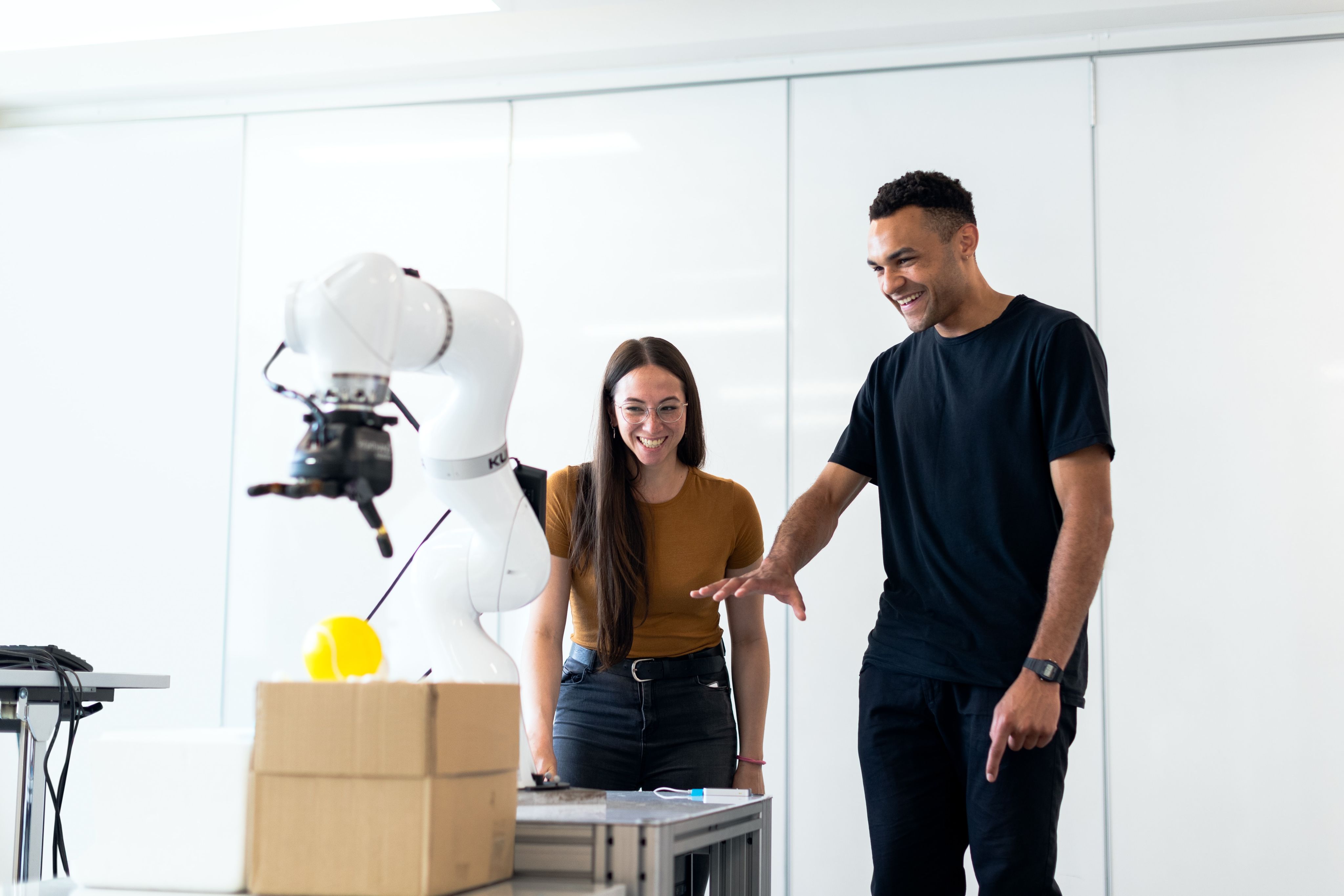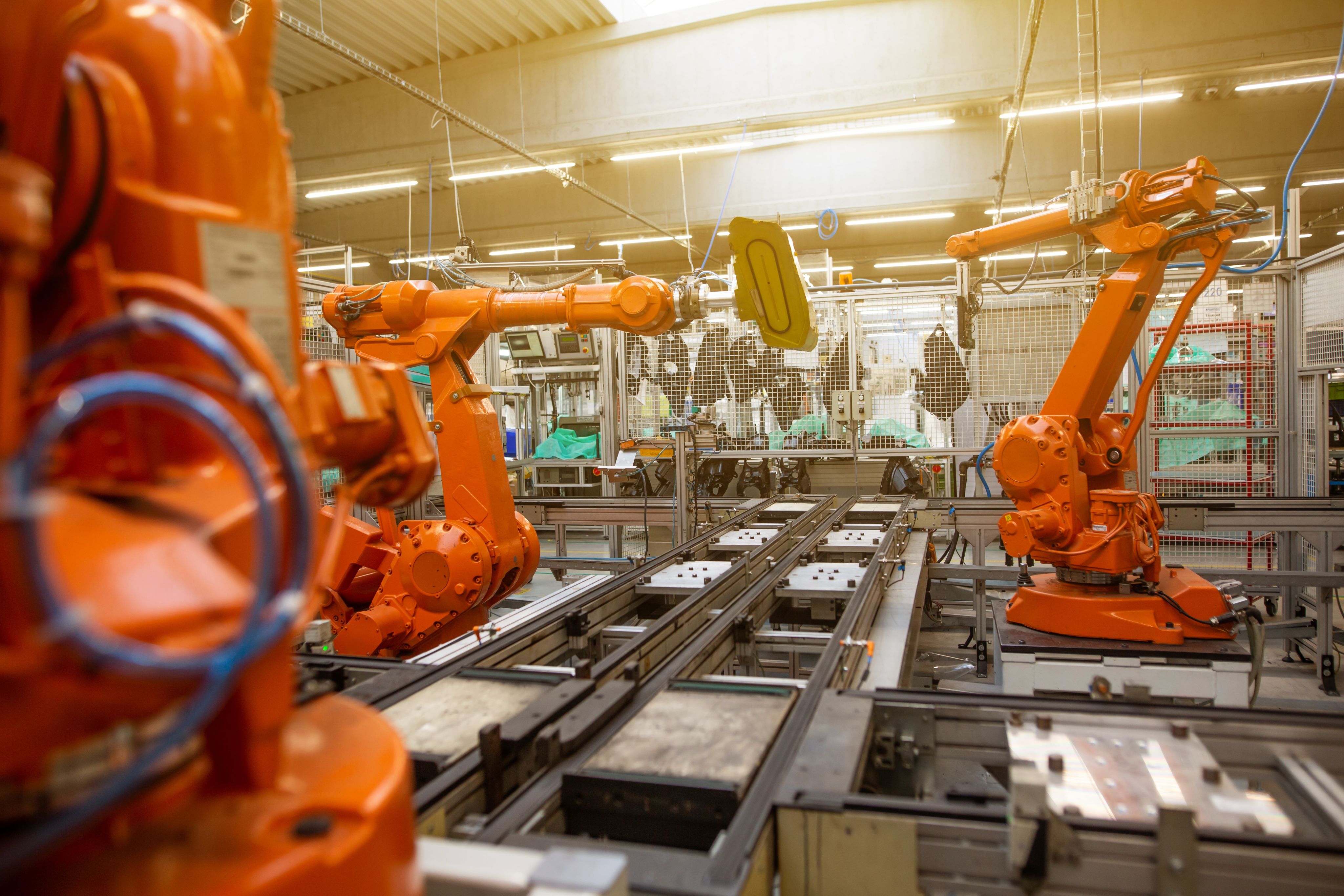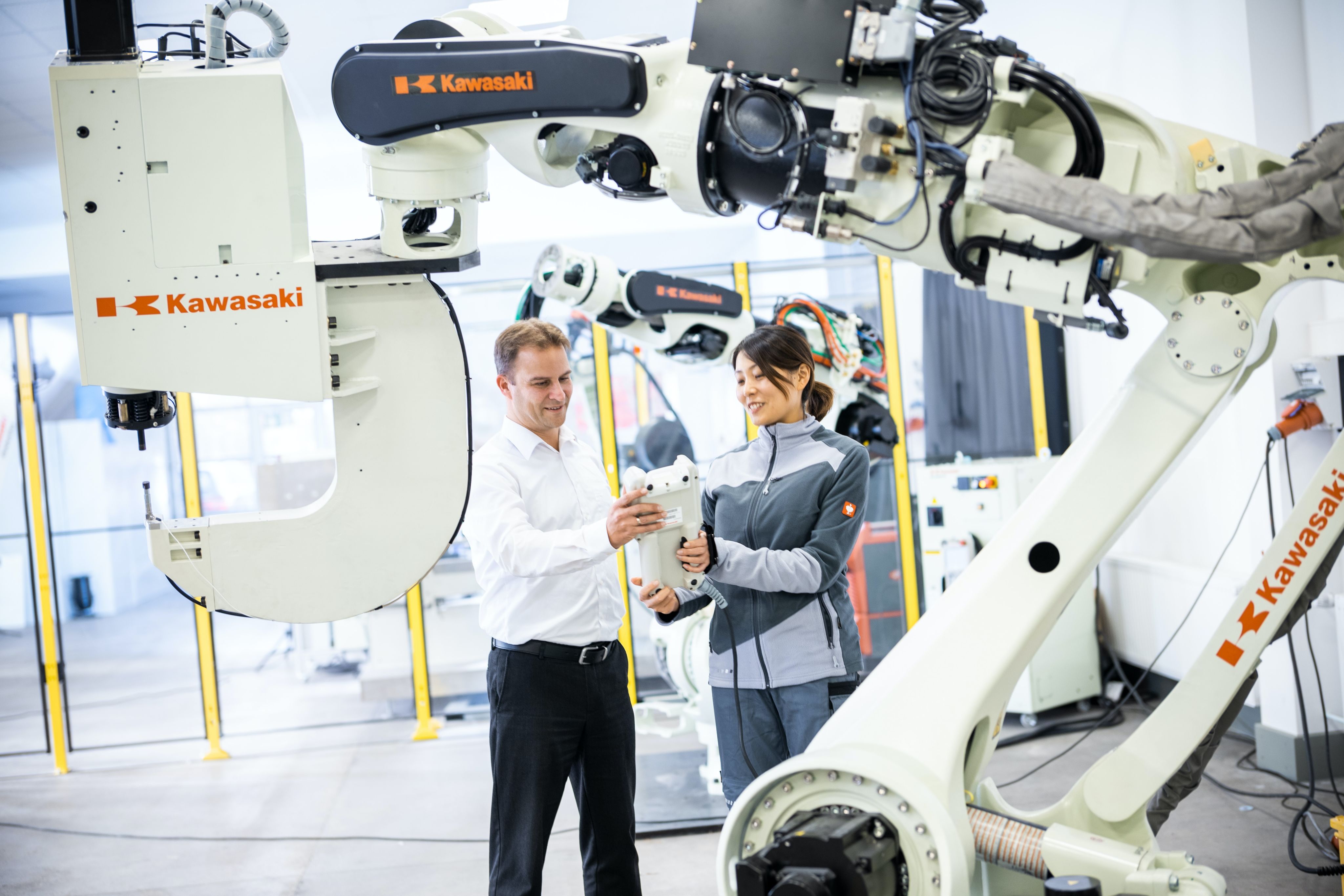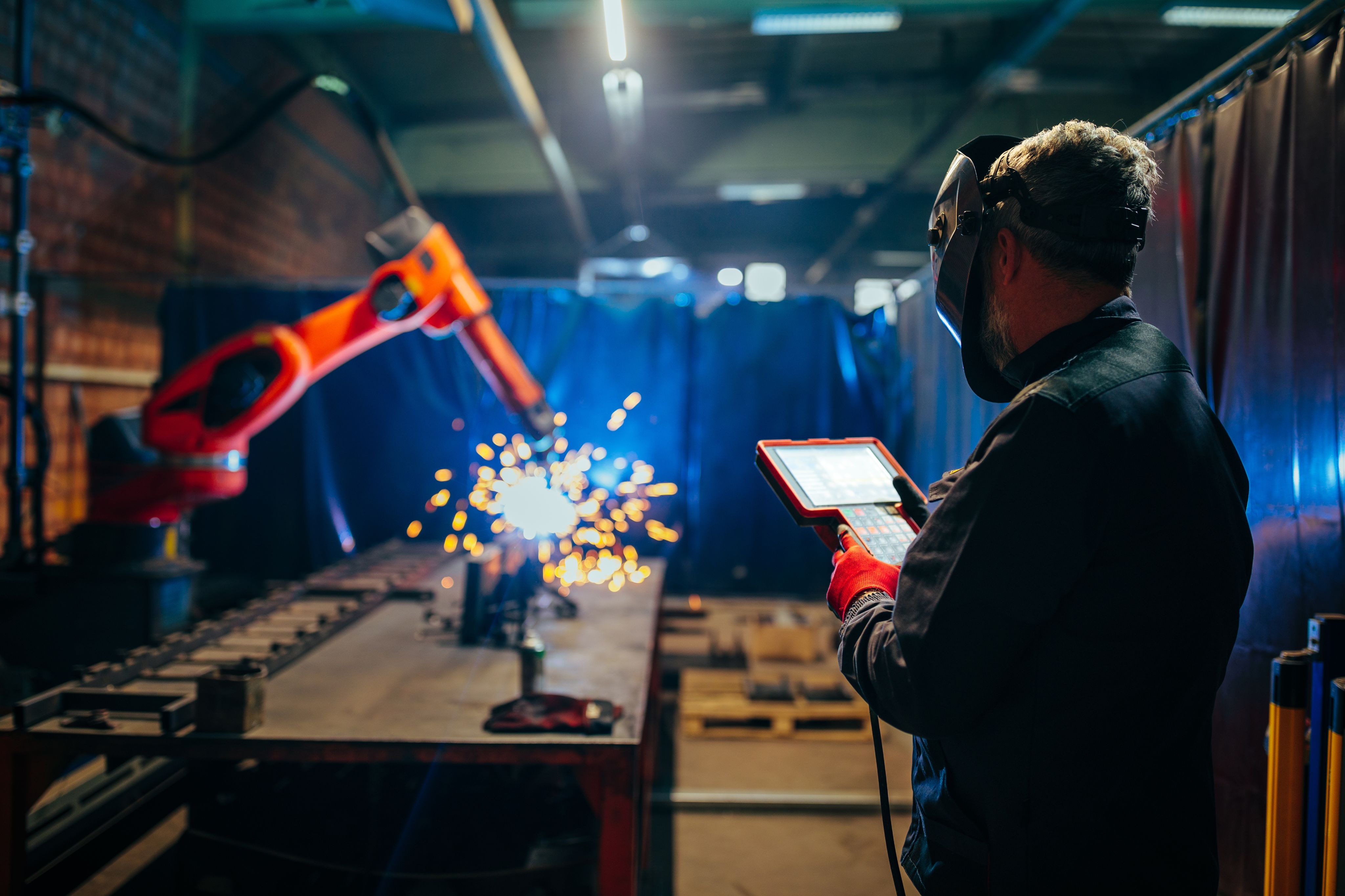Chapter 4:
Automation, AI and the future of work
Digital work revolution

Key insights
Robot use remains concentrated in large firms and the manufacturing sector. Service robots – often AI-enabled – are still in the early stages of adoption, particularly among SMEs.
AI-embedded robotics is enabling more complex, adaptive tasks. As a result, the role of robots is being expanded beyond routine automation.
For now, robots are reshaping job roles, not eliminating them. They are taking over repetitive tasks while shifting workers toward oversight, problem solving and technical support.
Impacts on job quality are mixed. While robotics can reduce physical strain and improve safety, they may also limit autonomy, increase monitoring and raise cognitive demands
Innovations in robotics, algorithmic management and artificial intelligence (AI) accelerated during the COVID-19 pandemic and are changing how tasks are performed, managed and supervised. These innovations are also changing how businesses operate, generating new markets and increasing productivity.
While much of the current hype centres around generative AI, Eurofound research argues that AI is contributing to productivity gains when it is embedded in robotics and integrated into broader operational systems, rather than being applied narrowly to isolated tasks or processes. However, EU businesses have been slow to adopt advanced robots, particularly service robots, which are more complex than traditional industrial robots and can often incorporate AI into their operation.
Eurofound research explores the current landscape of robot adoption, the role of AI in robotics, and the implications of these technologies for work organisation, job quality and working conditions.
'Digitalisation is unfolding at a pace that feels faster than ever before, reshaping the world of work with implications for both workers and employers'

Prevalence of advanced robots in the EU

Between 2018 and 2022, the share of EU enterprises using robots remained relatively stable, with a slight decline from 6.7% to 6.3% (Figure 14). However, the number of robot installations increased, reflecting a concentration of automation investments among enterprises that already use robots.
Figure 14: Share of enterprises using industrial or service robots, EU Member States, 2018–2022 (%)
Robotics adoption is led by large enterprises
The use of industrial and service robots is correlated with company size. As Figure 15 shows, in all Member States (except Greece in the case of industrial robots), larger companies are more likely than smaller ones to use both types of robots, with wide variation across countries in terms of prevalence.
More than 1 in 3 large companies in Czechia and Slovenia use industrial robots, while the same is true for fewer than 5% of large companies in Cyprus and Greece. On average, around 1 in 5 large companies in the EU use industrial robots and only 1 in 10 use service robots.
Figure 15: Share of enterprises using industrial (A) and service (B) robots, by size of enterprise, EU, 2022 (%)
Manufacturing sector leads
The manufacturing sector is the main industry in which both industrial and service robots are used. More than 16% of EU enterprises in the manufacturing sector use industrial robots and around 4% use service robots (Figure 16).
Figure 16: Share of enterprises using industrial and service robots, by sector, EU, 2022 (%)
Industrial robots
An industrial robot (such as a robot used for welding, laser cutting or spray painting) is an automatically controlled, reprogrammable, multipurpose manipulator that can be programmed on three or more axes. Most industrial robots comprise a robotic arm and a series of links and joints, with an end effector that carries out the task at hand. They primarily perform repetitive tasks with minimal human interaction.
©Gorodenkoff/Adobe Stock
©Gorodenkoff/Adobe Stock
Service robots
A service robot (such as a robot used for surveillance, cleaning or transport) has a degree of autonomy and can operate in complex and dynamic environments.
It may require interaction with people, objects or other devices. Service robots use wheels or legs to achieve mobility and are often used in inspection, transport or maintenance tasks.
©Monopoly919/Adobe Stock
©Monopoly919/Adobe Stock
High precision drives robotics
The most important factor driving the adoption of robots within enterprises is the need to ensure high-precision outputs and processes, followed by the need to increase safety at work (Table 3).
Table 3: Main reasons enterprises use robots, EU Member States, 2022 (%)
However, the EU average hides a large variation between Member States. The need to ensure the high precision of outputs and services is the most frequently identified reason for robot adoption in Belgium, Denmark and Italy. These are also countries where the need to increase safety at work and the need to expand the range of goods and services are cited by many enterprises as key reasons for robot adoption. This indicates that the choices that enterprises make with regard to introducing robots in workplaces are often driven by several reasons.
Broader labour market trends such as increasing labour costs and labour shortages also drive enterprises to invest in robots. As discussed in Chapter 1, these shortages have become a structural issue across many sectors. On average, 2.2% of EU enterprises cited labour shortages as a driver of robot adoption in 2022.
What can AI-embedded robotics do?
While robot adoption varies across sectors and enterprise sizes, the capabilities of robots themselves are rapidly evolving, especially when powered by AI. This raises the question: what can AI-embedded robotics actually do?
Integrating AI applications and sensor technologies into robots equips them with additional competencies, such as machine vision, speech recognition and force (touch) sensing. For instance, integrating AI into a robot’s physical structure allows it to navigate autonomously without requiring continuous human input. Tactile sensing, enhanced by AI and sensors, allows robots to ‘feel’ and respond to different levels of force or pressure, making it possible for them to handle fragile materials, such as those in laboratory settings. General-purpose AI, including generative AI, has the potential to further enhance human–robot interaction by allowing robots to perform a diverse range of tasks.
Advanced robotic applications are also emerging in the health and services sectors. One example is Buddy, a social robot with integrated AI capabilities, currently used as a telepresence robot in classrooms, enabling children in hospitals or long-term care to attend school remotely. Buddy becomes the avatar of the child, allowing them to interact with other students and teachers by adding movements and emotions to their messages. The child controls the robot remotely using a tablet.
Embedding AI: Gradual but fundamental shift
It is important to note that having AI embedded in robotics, especially in manufacturing, is not about making marginal improvements. Rather, it enables fundamentally different ways of doing things. However, this kind of transformation does not happen overnight, generative AI or not. When embedded in robotic applications, AI must be highly precise, significantly increasing both the complexity of deployment and the level of required investment.
In practice, many establishments that have implemented the most advanced robotic systems have followed an incremental approach, implementing automation technologies gradually and in stages, rather than through large-scale overhauls. In such complex systems, AI technologies are often integrated into hardware and control systems, adding an extra layer to existing production processes, with the aim of optimising efficiency. This integration makes it challenging – particularly for external observers – to identify AI components without having a detailed knowledge of a system’s architecture.

Will robots take my job?

While factors like the need for high precision and labour shortages drive adoption, many workers are left with worries that these robots will take over their jobs. Case studies conducted by Eurofound found no evidence of redundancies due to automation. Rather, they are gradually redefining how work is organised and executed.
In reality, organisations tend to take a cautious approach to technology adoption, relying on proven business cases. Eurofound’s case studies show that while robotic technologies primarily automated manual and repetitive tasks, they did not cause entire job profiles to disappear. By taking over repetitive or physically demanding tasks, they help reduce physical strain and lower the risks of injuries or accidents.
Automation has reconfigured work tasks, requiring workers to shift towards supervisory and maintenance roles. Other case studies show how robotics can actually lead to the creation of new technical jobs, such as in an Italian warehouse, where automation has increased demand for hardware engineers, software engineers and safety experts.
Despite no evidence of redundancies due to automation, concerns about future job losses persist. These fears are not unfounded. Eurofound’s case studies show that future plans for many businesses indicate an intention to automate as many tasks as possible.
A double-edged sword for job quality
Beyond employment, the integration of robotics and AI is reshaping the nature of work itself, bringing both opportunities and challenges for job quality.
On the one hand, automation can eliminate physically strenuous, repetitive or monotonous tasks, helping to reduce the risk of workplace accidents and improving working conditions. For instance, in one Italian hospital, automating the preparation and distribution of medication enabled nursing staff to dedicate more time to patient care – a more meaningful but also more demanding aspect of their work.
On the other hand, however, automation is also reshaping the nature and intensity of work. Many systems, particularly in warehouse settings, incorporate algorithmic management features that direct workers step by step, specifying what items to pick, where to move them and how to execute each action. These systems, such as mobile shelving robots, enhance efficiency and standardise job routines but limit workers’ autonomy.
This was observed in a Lithuanian manufacturing plant, where automation led to a profound transformation in shop-floor work. Instead of physically assembling products, workers now use digital workstations to monitor machine performance and intervene when issues arise. While this shift has made the work less repetitive and more focused on problem-solving, it also places greater demands on workers, who must be able to interpret system feedback and ensure production continuity.
Ultimately, the impact of robotics on job quality is not determined by the technology itself, but by how it is integrated into workflows, how much autonomy and control workers retain, and the level of training and support provided during implementation.
Impact of robots on working conditions
Survey data from the OSH Pulse survey, commissioned by the European Agency for Safety and Health at Work (EU-OSHA), were analysed by Eurofound, to shed further light on the impact of robots on working conditions. While only around 3% of survey respondents reported using such robots in their main job, the findings highlight significant differences in job experiences. As shown in Figure 17, workers using robots that interact with humans were:
- 11% more likely to report an increased pace of work
- 8.7% more likely to experience increased surveillance
- 7% more likely to report reduced autonomy
- 5% more likely to report a heavier workload and a higher likelihood of working alone
Figure 17: Average marginal effect of robot use on working conditions
These findings suggest that the occupational safety and health (OSH) gains typically associated with robotics – such as reduced exposure to physical risks – need to be weighed against potential negative impacts on working time, workload, autonomy and social interaction. This underscores the importance of preventing and managing psychosocial risks when introducing robotic technologies in the workplace.

Human–robot interaction

As advanced robotics and AI systems become more embedded in the workplace, new forms of human–machine collaboration have emerged. These technologies are not only changing how work is carried out, but also how it is managed and experienced. Two key developments in this transformation are the growing use of collaborative robots (cobots) in manufacturing (see the case study below on the Finnish medical device factory) and the expansion of algorithmic management systems across sectors.
Cobots on the assembly line: Case study from a Finnish medical device factory
Collaborative robotics in manufacturing
Human–robot interaction is most developed in manufacturing, particularly along assembly lines, where collaborative robotic applications – known as cobots – support workers with specific tasks, such as precision work, welding and gluing. The use of cobots helps to improve production quality while easing ergonomic burdens for workers.
In a Finnish medical device factory, cobots were deployed to assist workers in assembling products, especially tasks that require accuracy and steadiness – such as gluing small components. The use of cobots was aimed at both improving output quality and reducing physical strain on the shop floor.
Integrating multiple robotic systems
The case study also highlights how different types of robotic technologies can be combined. Alongside cobots, the factory had introduced advanced guided vehicles (AGVs) and autonomous mobile robots (AMRs), which typically involve lower levels of human–robot interaction and are mainly used for monitoring, maintenance and exception handling.
At the time of the field visit, the factory was prototyping a mobile robot designed to move cobots between production lines, depending on current demands. This robot uses sensors, algorithms and navigation systems to move autonomously, adapting in real time to the factory environment. Once in position, the cobot automatically downloads the relevant software and adjusts its tools to suit the assembly line’s needs.
Changes to work organisation and conditions
The introduction of cobots impacted working conditions, particularly in terms of autonomy and pace of work. Workers reported some frustration with the slower pace introduced by the cobots, as they had to wait for the robot to complete its programmed task before they could begin theirs.
©gumpapa/Adobe Stock
©gumpapa/Adobe Stock
©greenbutterfly/Adobe Stock
©greenbutterfly/Adobe Stock
Algorithmic management: The invisible layer of automation
While cobots represent the physical side of automation, algorithmic management systems increasingly shape the organisational and managerial dimension of work. These systems use computer-programmed procedures, sometimes enhanced by AI, to automate a broad range of traditional management functions from hiring and shift allocation to monitoring performance and evaluating outcomes.
Although initially used in the platform economy, algorithmic systems are increasingly used in other sectors such as warehousing, logistics, manufacturing and customer service. These systems allocate tasks, monitor output and evaluate performance, reshaping the world of work. In warehouses, for example, algorithmic management is embedded in machine vision and robotic shelving systems, which dictate what items workers should pick, move or store.
The growing presence of algorithmic tools in traditional workplaces highlights the urgency of creating comprehensive, anticipatory regulation.
Regulatory responses: Evolving but fragmented
The regulatory response to algorithmic management remains uneven. While general safeguards exist under the General Data Protection Regulation (GDPR), there is no comprehensive EU framework governing its use across sectors.
A notable step was the provisional agreement on the Platform Work Directive (2024), which introduces rights to human oversight and transparency in automated decision-making. Although designed for platform workers, this legislation may serve as a reference for managing algorithmic systems more broadly as they become embedded across the economy.

Shaping the future: A human-centric approach

Given the complexities described above, a human-centric approach is essential to ensure that technological change delivers good outcomes for workers. In the context of advanced robotics, this means ensuring that systems are designed and deployed in a manner that respects human values and fundamental rights. Rather than simply replacing human labour, robots and AI-powered technologies should complement human capabilities, supporting workers in performing tasks and adapting to changing roles.
Eurofound’s ongoing research supports this transformation by providing evidence-based insights to policymakers. Monitoring instruments such as the European Working Conditions Survey (EWCS) are critical in capturing how new technologies are reshaping the workplace. The latest wave of the EWCS, with fieldwork conducted in 2024, includes new indicators on the use of digital tools, such as technologies used to allocate tasks, schedule working time and monitor performance. These data will be instrumental in tracking the real-world impact of digitalisation and ensuring that the shift towards AI and other emerging technologies remains anchored in human-centric values.










